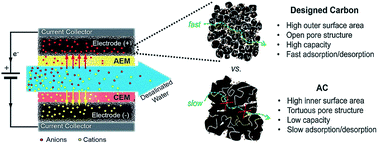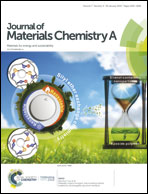Highly compact, free-standing porous electrodes from polymer-derived nanoporous carbons for efficient electrochemical capacitive deionization†
Abstract
Electrochemical capacitive deionization (CDI) is a promising technology for distributed and energy-efficient water desalination. The development of high-performance, low-cost capacitive electrodes is critical for enhancing CDI performance and scaling up its applications. Here, we report a novel design of highly compact, free-standing nanoporous carbon film electrodes for high-performance CDI. Such porous electrodes are fabricated by slip-roll compressing polypyrrole (PPy)-derived activated microporous carbon particles (PPy-AMC) with a small amount of polymer binder (5 wt%). The unique PPy-AMCs are synthesized from a rigid polymer precursor using a scalable carbonization-activation process, which is adopted in the manufacturing of commercial activated carbons. With small and uniform particle size, large specific surface area and short diffusion length, the PPy-AMC-based compact carbon electrodes offer very high salt adsorption capacity and enable very fast desalination, which significantly outperforms the state-of-the-art porous carbon-based CDI electrodes. This work provides an important strategy to design and fabricate compact yet porous carbon electrodes for efficient water desalinization and can be potentially extended to other applications such as energy storage and conversion.



 Please wait while we load your content...
Please wait while we load your content...